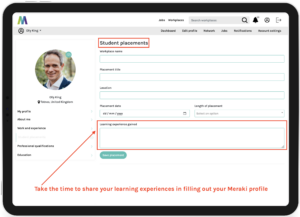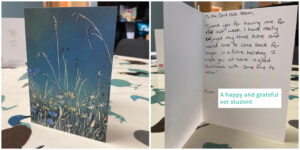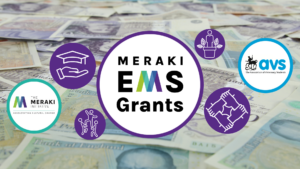by Olly King, Founder
Meraki HQ, Totnes, UK
Created 725 days ago
Clinical Extra-Mural Studies Top Tips: Part 3 - Things to do After Your Veterinary Placement
Congratulations! You are one placement closer to meeting your RCVS C-EMS requirements. In Part 1 we covered the logistics of sourcing and arranging your placements and in Part 2 we focused on building relationships to integrate yourself into the team. We now consider tips to maximise your personal and professional development ready to get more out of your next placement and re-enforce a what you have seen and learnt.
1. Ask for direct feedback
If you strive to become the best version of yourself, get comfortable receiving and proactively asking for feedback. Knowing how well you perform is an essential part of life-long learning. It is also helps embrace a growth-mindset, reduce negative perfectionist traits and encourages greater self-compassion.
Perfectionism, the fear of failure and its associated links with shame and embarrassment, are strong traits of the achievement orientated type-A personality. These traits pre-dispose to low self-esteem, stress, anxiety and poor communication styles. With many veterinarians having a type-A personality, it is good to be aware how these traits may show up in you.
By welcoming and being open to constructive feedback you demonstrate a willingness to improve. This will heighten your self-awareness, soften the fear of failure and ensure you achieve your goals quicker for a more fulfilling career.
The focus of most students is invariably on clinical skills and knowledge. However effective communication and managing workplace relationships are without doubt the hardest skills to master. They are also more likely to influence your career success. So be courageous, lean into the discomfort of asking for feedback, then take action to improve yourself before it shows up negatively to adversely impact your career.
Set yourself small feedback goals. Rather than just giving your placement supervisor your feedback form to complete, arrange to have a sit down conversation, ideally undisturbed. If time does not allow at the end of your placement, arrange a telephone or video call in the immediate days after.
Do not fixate on any perceived negative feedback (another perfectionist trait!), there will be plenty of positives too. Be sure you thank the person for sharing their insights. But remember, feedback is a personal opinion and does not reflect your identity as a whole.
As your confidence grows, embrace diverse feedback from people in different job roles. Emailing a short self-assembled Google Doc or SurveyMonkey questionnaire to people in the workplace who you shadowed is an easy way to do this.
Question themes could mirror those on your university C-EMS Supervisor Feedback form, such as interpersonal skills, to deepen your learning. For example, asking people who you spent time with: ‘imagine I was your colleague, what would you like best and least about working with me?’ and ‘please share two tips to help me improve my communication’.
“We do not learn from experience, we learn by reflecting on experience.”
John Dewey
2. Post-placement reflection
Just as life is lived in the moment but understood by looking back, your EMS experience is no different. Getting into this mindset will serve you well in all aspects of your life and career.
Taking the time to reflect on your EMS experiences will accelerate your growth and learning, helping you become a confident new graduate. Your university will likely provide guidance on this, requiring you to submit an online placement reflection as part of your academic requirements.
One such reflective model is Gibbs six-stage reflective cycle. Designed to enable learning from experience and planning for future situations, it is broken down into six stages:
- Description – What happened? Who, what, when, where, how, why.
- Feelings – What were you feeling before, during and after the experience?
- Evaluation – What was the outcome? What went well and not so well? What did you or others contribute (positively and or negatively) to this experience?
- Analysis – What were any possible consequences? Why did things go well or not so well? What knowledge (eg. teachings, placement feedback, discussion with tutors) can help you understand the experience?
- Conclusion – What did you learn from the experience? How could it have been improved? What do you need to work on for next time?
- Action plan – What will you do differently next time?
For those curious to learn more about reflective writing, see this reflection guide and various models of reflection.
If you endured a bad placement, your reflection will help you objectively and rationally process the experience. Framed in this context it will avoid you simply blaming and being harshly critical of your performance.
The AVS 2018 EMS Survey highlighted student feedback of being ignored, resented for asking questions and being made to feel as though they were in the way. If you have endured such a placement, know that your experience is unlikely to be a reflection of you, so do not take anything to heart. If the workplace ask and if you feel comfortable doing so, share your reflections with them to help them improve the placement experience for the next student.
Most importantly, however, learn from the experience. Talking to your university tutor and peers can provide a cathartic release and provide tips you can take to avoid a similar future experience.
3. Leave each placement positively
Do your utmost to leave each placement in a positive and professional manner, especially if you have had a challenging experience. It is a small, interconnected profession with a lot of flux between workplaces and roles. So while you cannot control how others act and behave, be sure you maintain your integrity and civility.
In line with university guidance, share any interpersonal conflicts, safety, harassment and discriminatory and wellbeing concerns with your tutors, to safeguard future students.
Figure 1: Meraki Career Profile – Use the student placement section to share your EMS accomplishments.

4. Update your Meraki career profile
Within the ‘Student placements’ section of your Meraki career profile you can write a concise summary of the knowledge, experiences and key learnings from your placements (Figure 1).
This may simply be a copy of a reflection you submit as part of for your university assessment. This is really useful information to share with future placements and prospective employers, so be sure to keep this up-to-date ahead of sharing your profile with your next placement.
Note, the ‘Student placement’ section is not an opportunity to review a bad placement.
This is important to avoid landing yourself in hot water when sharing your profile with a third-party. All information within your career profile is about you, just as it is in your CV. It is not about others.
5. Send a thank you card
Take a card in on your last day or post a card afterward to thank the team (Figure 2). Say what you enjoyed most. If you made new friends while on placement and got some pictures of you having a great time, you might like to even use one of these to personalise a Moonpig card. That will certainly stand out in the staff room to leave a lasting impression!
Figure 2: Sending a card after an EMS placement is a kind and thoughtful gesture that will get you remembered.

6. Re-book and keep in touch with the best practices
Practices are increasingly using C-EMS as a way to recruit prospective new graduates well before graduation. In 2018, nearly 60% of graduates reported receiving a job offer from at least one of their C-EMS practices. Amidst the ongoing shortage of veterinary talent, this is now likely an underestimation.
A strong connection between students, their hosting placement workplaces and where new graduates accept their first role undoubtedly exists. While this is to your advantage, competition for jobs at the best workplaces will always remain. So if you have enjoyed the team and culture and would be open to a role if one were available, be sure to let them know!
If you do enjoy a great experience with a particular practice that went out of their way to support you, then 100% re-book – ideally before you finish your current placement. Asking to go back is a powerful way to signify your enthusiasm and desire to build a stronger relationship with the team. Going back you are always more likely to get more involved next time, and this is how C-EMS turns into an extended job interview. Even if no interview or job offer emerges, you will reap plenty of transferable skills and confidence to impress your next placement.
7. Refer top workplaces to Meraki
To help everyone enjoy a fulfilling career we are on the hunt for the best places to work to showcase on our veterinary employer directory. If you have had an amazing C-EMS experience, then be sure to let us know at olly@merakiinitiative.com.
Better still, signpost them to us! If you successfully refer a workplace to us who then takes out a paid subscription, we will send you a £50 ‘Thank you’ voucher. Note you must be a registered Meraki user.
8. Apply for a Meraki EMS Grant
To encourage you to integrate and build personable relationships while on EMS placements we are giving away FREE CASH in exchange for a ‘people picture’ that best portrays your experiences with the team (Figure 3).
To apply, share a short caption to describe the context of the image. For example, say what was going on before the picture was taken, or use it as an opportunity to share positive feedback and how they helped you achieve your learning objectives.
Click here for details of how to apply.
Figure 3: Meraki EMS Grants – Encourage team integration and relationship building on placement.

Summary
To recap, key take-aways from this three-part guide to getting more out of your C-EMS placements:
- Take the time to find the right placements
- Set clinical and non-clinical skills objectives
- Be an enthusiastic team player
- Build personable relationships
- Get stuck in to work and practice life
- Ask for feedback and
- Reflect on your experience and learning post-placement.
Good luck on your next placement!
Click here to review Part 1 of our ultimate C-EMS guide – Planning your Veterinary Placements
Click here to review Part 2 of our ultimate C-EMS guide – Things to do During Your Placement
EMS insights to check out
GUVMA President Shares His C-EMS Experiences
Centaur Society President Shares Her C-EMS Experiences
Got an EMS story you would like to share in our next newsletter? Get in touch with olly@merakiinitiative.com

